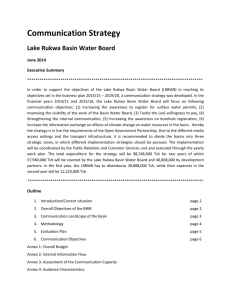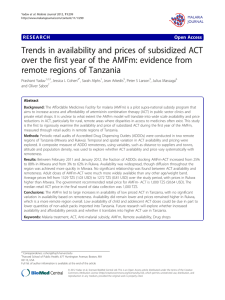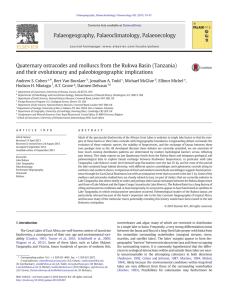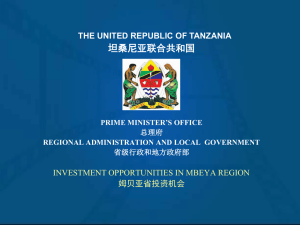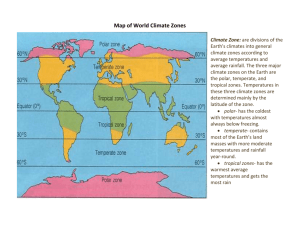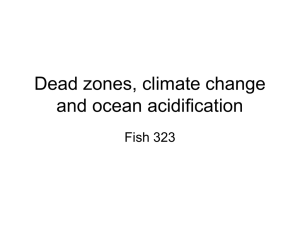Rukwa Region in brief
advertisement
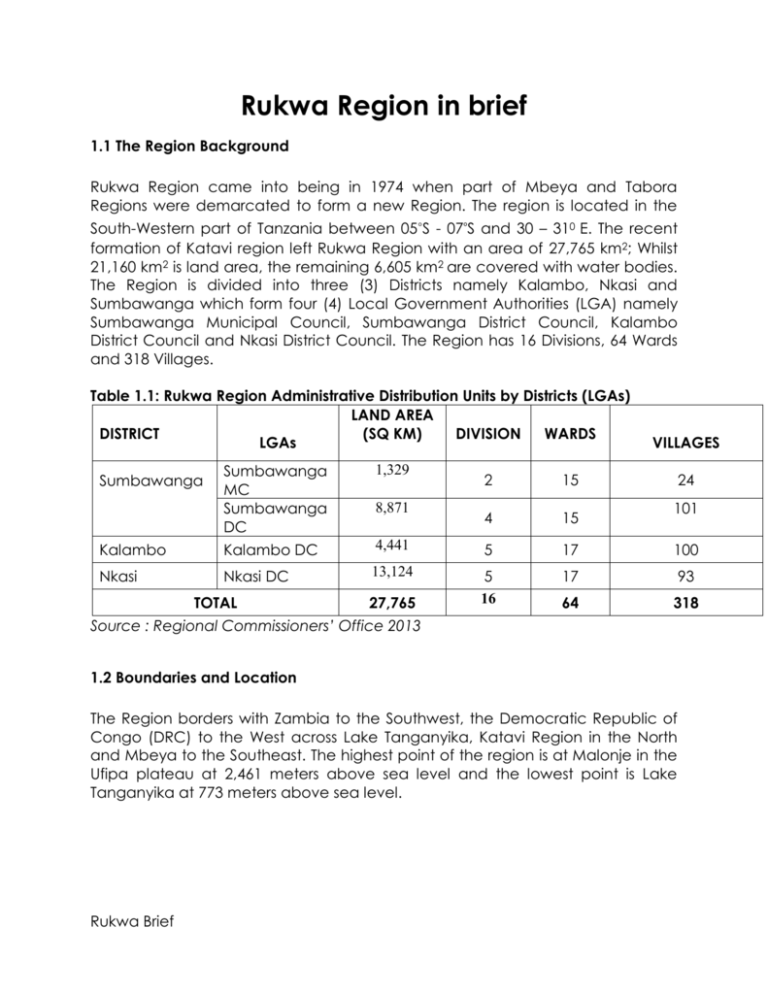
Rukwa Region in brief 1.1 The Region Background Rukwa Region came into being in 1974 when part of Mbeya and Tabora Regions were demarcated to form a new Region. The region is located in the South-Western part of Tanzania between 05◦S - 07ºS and 30 – 310 E. The recent formation of Katavi region left Rukwa Region with an area of 27,765 km2; Whilst 21,160 km2 is land area, the remaining 6,605 km2 are covered with water bodies. The Region is divided into three (3) Districts namely Kalambo, Nkasi and Sumbawanga which form four (4) Local Government Authorities (LGA) namely Sumbawanga Municipal Council, Sumbawanga District Council, Kalambo District Council and Nkasi District Council. The Region has 16 Divisions, 64 Wards and 318 Villages. Table 1.1: Rukwa Region Administrative Distribution Units by Districts (LGAs) LAND AREA DISTRICT (SQ KM) DIVISION WARDS LGAs VILLAGES Sumbawanga MC Sumbawanga DC 1,329 2 15 8,871 4 15 Kalambo Kalambo DC 4,441 5 17 100 Nkasi Nkasi DC 13,124 5 16 17 93 64 318 Sumbawanga TOTAL 27,765 24 101 Source : Regional Commissioners’ Office 2013 1.2 Boundaries and Location The Region borders with Zambia to the Southwest, the Democratic Republic of Congo (DRC) to the West across Lake Tanganyika, Katavi Region in the North and Mbeya to the Southeast. The highest point of the region is at Malonje in the Ufipa plateau at 2,461 meters above sea level and the lowest point is Lake Tanganyika at 773 meters above sea level. Rukwa Brief 1.3 Climate The Region enjoys tropical climate with mean temperatures ranging between 13oC in some places for the months of June and July to 270C in the hottest months of October to December. We have unimodal reliable rainfall for many years; it ranges between 800 – 1300 mm per annum falling from November through May. The dry season occurs after the rain season and lasts in October. 1.4 People and Culture The major languages spoken in this region include Swahili, Fipa, Mambwe, Lungu, Nyamwanga and English is also spoken by limited number of people. With exception of English and Swahili, the other spoken languages are vernacular (specific to a particular tribe). The main staple foods are maize, rice and beans with exception of some parts of Lake Tanganyika and Rukwa where cassava, fish and rice are the main source of food. Other food crops widely available include groundnuts, finger millet, potatoes, sorghum, wheat and sugarcane. Meat is easily available from the Agro-pastoral’s community who traditionally keep varieties of domestic animals such as cattle, goats, sheep, pigs, rabbits chicken, ducks, guinea fowls, and pigeons. 1.5 Region Population According to 2012 Population and Housing Census the Region had a population of 1,004,539 people, 487,311 being males and 517,228 females and the forecast for 2014 is 1,076,087 people according to the National Bureau of Statistics (NBS) as per growth rate of 3.5%. Table 1.2: Population of Rukwa Region by Sex in Districts/Council S/N District/Council Male Female Total 1 2 Kalambo District Council Sumbawanga District Council Nkasi District Council Sumbawanga Municipal Council 100,474 149,062 107,226 156,784 207,700 305,846 Average Household Size 4.9 5.0 137,041 100,734 144,159 109,059 281,200 209,793 5.3 4.8 487,311 517,228 1,004,539 5.0 3 4 Total Rukwa Brief Source: NBS (National population and housing Census 2012) Table 1.3: Region Population & Population density and Growth rate by District / LGAs District (LGAs) POPULATION LAND AREA (SQ KM) Census 2012 2012 Population Density 2014 Projection 2014 Population Density % Increase 2012-2014 115.1 227,349 171.1 4.1 44.3 3.3 Sumbawanga MC 1,329 209,793 Sumbawanga DC 8,871 305,846 Kalambo DC 4,441 207,700 33.2 220,776 46.8 3.1 Nkasi DC 13,124 281,200 23.1 301,225 32.1 3.5 32.5 1,075,716 47.2 3.5 29.2 326,366 TOTAL 27,765 1,004,539 Source: National Bureau of Statistics (NBS). 1.6. Economy The economic growth rate in terms of GDP at current market price in 2010, 2011 and 2012 was 1,092,300, 1,293,386 and 1,529,289 respectivelly. Per capita income for 2010, 2011 and 2012 was 726,658, 830,052 and 974,601 respectivelly. Table 1.4: Rukwa Region Share Contribution Regional to the Gross Domestic Product and Per Capita Income since 1999 to 2013 Year GDP Tanzania Mainland Rukwa Region 1999 2000 2001 2002 2003 2004 2005 2006 2007 2008 2009 2010 7,222,560 8,152,790 9,100,274 10,444,507 12,107,062 13,971,592 15,965,294 17,941,268 20,948,403 24,781,679 28,212,646 32,293,479 269,877 295,030 297,632 337,155 429,981 483,240 547,334 611,089 724,781 871,896 974,823 1,095,346 2011 37,532,962 1,293,386 Rukwa Brief PER CAPITA INCOME Tanzania Rukwa Region Mainland 233,397 255,080 255,575 270,511 276,741 264,731 310,991 295,299 353,496 367,565 396,154 398,486 441,063 437,274 478,100 469,246 547,081 537,042 627,787 623,288 693,470 672,237 770,464 728,684 869,436 830,052 2012 44,717,663 1,529,289 1,025,038 974,601 1.7 Age Dependency Ratio The age dependency ratio is defined as the ratio of the youths less than 15 years of age plus persons aged 65 years and above (dependants) to adults aged 1564 years (workforce). According to population and housing census 2012 in Rukwa Region more than half of population is young. The overall dependency ratio was 1:2 Age dependency ratio was high in rural areas than urban areas. 1.8. Ecological Zones Rukwa region has three (3) agro-ecological zones. The features of the zones are shown in the Table below:Table 1.5: Agro-ecological zones of Rukwa Region Zones Area (sq km) General Morphology Altitude range (m) Dominant soil Economic activity Rukwa Valley 6,500 Flat plains 810-1200 Sandy Agric: Maize, paddy, 800-1000 Cassava, sesamme, Cattle, goats, sheep and Fishing. Agriculture: maize, 800-1200 cassava, Oil palm, paddy. Fishing, Lake 4,500 Tanganyika Shores Ufipa Plateau 11,800 Steep hills 772-1631 with gentle plateaux and plains Gentle plain 1000-2461 with moderately slopping hills and plateau Source: BLARUP, 1997 Rukwa Brief Shallow, scattered clayey lacustrines Ferralitic Rainfall (mm) Agriculture: maize, 800-1200 cassava, groundnuts, Millets, beans. Cattle, Goats. Fishing. Mining: coal, gemstones.
